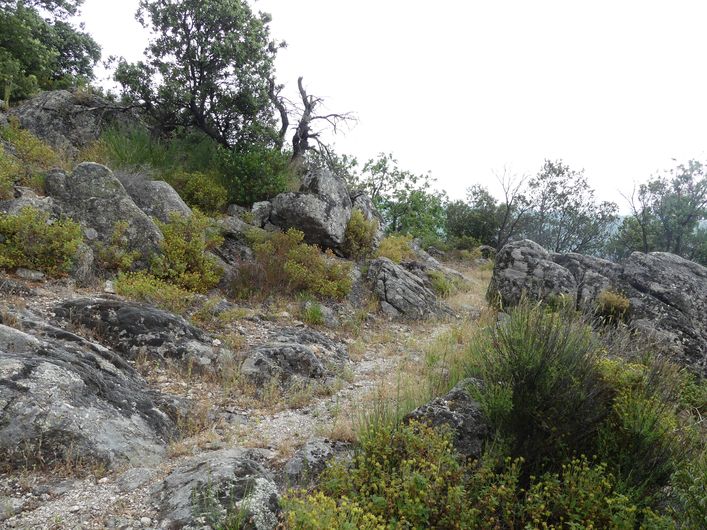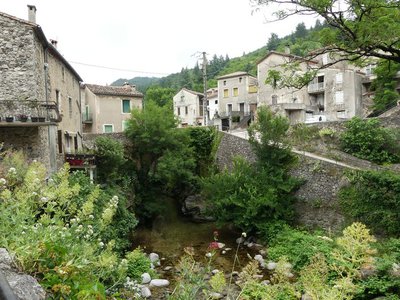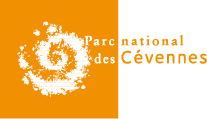
Around Aulas
3 points of interest

 History
HistoryRiver management
Lords were responsible for managing non-navigable rivers. Since building a mill was expensive, funding was provided by lords or religious orders. Mills were a substantial source of income. Sometimes, a lord sold his rights. In 1275, “the baron of Hierle, Guillaume d'Anduze, who had a pressing need for money, granted the inhabitants [of Aulas] significant tax exemptions in exchange for 6 000 livres tournois”.
Le ruisseau de Coudoulous - Nathalie Thomas  History
HistoryCoudoulous river
From the road, you overlook Coudoulous river. On its banks were the mills and spinning-mills of Aulas. In around 1870, a carding factory was established near the bridge. During a visit of the workshops by the owner, his wife’s hoop skirt caught in the gears of a waterwheel. It was impossible to bring the machine to an immediate stop and the poor woman died the following day, her bones crushed.
In the feudal era, the village was well-known for its mills. The numerous fulling mills were used to make sheets. Other mills dotted the banks too: flour mills and oil mills (olive and walnut). According to Adrienne Durand Tullou, in 1550 there were 17 mills (nine flour, six fulling and two oil mills) in Aulas.
Le village d'Aulas - Nathalie Thomas  History
HistoryThe village of Aulas
In the old days, the Place de l’Airette was where the wheat was thrashed. The village’s two fountains – on the Place de l'Airette and on the church square – were created on the initiative of the village council in 1887. They were almost removed when the houses were connected to mains water but were preserved by the support of certain councillors. Aulas was called Aulacio in 1001, from the Latin man’s name Aulas. In the 14th century, the village was fortified due to the many groups of brigands in the area. The ramparts were bordered by ditches and had gates. One of them, La Poterne, can still be seen. The village has remained picturesque thanks to its narrow lanes, its covered passage and its old buildings.
Description
Signposts will guide you all along this route. In the description below, the signposted place names and/or directions are given in bold italics between quotation marks:
Starting at the Mairie (town hall) of Aulas, go downhill to the river, passing in front of the restaurant to get to Le Pont.
- At "Quartier du Pont", take "Pratcoustal 3,6 km"; go uphill on the road, then on a path.
- At "Pratcoustal" walk to "Aulas" via:
- "Camieu" and
- "Aulas-Temple", on the GR®7 long-distance path.
This walk is taken from the guidebook Les Vallées Cévenoles - En Pays Viganais, published by the Communauté de communes Pays Viganais-Cévennes as part of the collection Espaces Naturels Gardois and the label Gard Pleine Nature.
- Departure : Aulas
- Arrival : Aulas
- Towns crossed : Aulas, Arphy, and Bréau-Mars
Forecast
Altimetric profile
Recommandations
Make sure your equipment is appropriate for the day’s weather conditions. Take enough water, wear sturdy shoes and put on a hat. Please close all gates and barriers behind you.
Information desks
Tourism & national parc'house
Col de la Serreyrède, 30570 Val d'Aigoual
The Maison de l'Aigoual houses the tourism office Mont Aigoual Causses Cévennes and the Maison du Parc national. This visitor centre provides information on and raises awareness of the Cévennes National Park, its sites and events as well as the rules that must be observed in the National Park's central zone.
On site: changing exhibitions, video projections, Festival Nature events and shop Open year-round
Tourism office Cévennes and Navacelles, Le Vigan
Maison de pays, place du Marché, BP 21, 30120 Le Vigan
This office is part of the National Park's associated tourist-information network, whose mission is to provide information on, and raise awareness of, the sites and events as well as the rules that must be observed in the National Park's central zone.
Open year-round
Access and parking
From Le Vigan take the D 999 towards Cavaillac, then the D1 90 to Aulas.
Parking :
Calculateur d'itinéraire Lio
Utilisez le calculateur liO pour organiser votre trajet en région Occitanie.
Autres régions
Calculez votre itinéraire en Auvergne Rhône Alpes sur Oùra
Biodiversité autour de l'itinéraire
Source


Report a problem or an error
If you have found an error on this page or if you have noticed any problems during your hike, please report them to us here:


